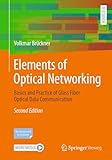Elements of optical networking [2nd ed.] : basics and practice of glass fiber optical data communication
Publication details: Springer Vieweg 2024 WiesbadenEdition: 2nd edDescription: xii, 251pISBN:- 9783658432409
- 621.3824 B831e2
| Item type | Current library | Collection | Call number | Status | Date due | Barcode | Item holds | |
|---|---|---|---|---|---|---|---|---|
 Books
Books
|
PK Kelkar Library, IIT Kanpur | General Stacks | 621.3824 B831e2 (Browse shelf(Opens below)) | Available | A187067 |
Browsing PK Kelkar Library, IIT Kanpur shelves, Shelving location: General Stacks, Collection: General Stacks Close shelf browser (Hides shelf browser)

|

|

|

|

|

|

|
||
| 621.382 D649q Quantum communication, quantum networks, and quantum sensing | 621.382 F524d Digital communications a foundational approach | 621.382 Z61d Differential antennas theory and practice | 621.3824 B831e2 Elements of optical networking [2nd ed.] basics and practice of glass fiber optical data communication | 621.38275 L16a Advanced fiber access networks | 621.384 H757m Microwave and millimeter-wave antenna design for 5G smartphone applications | 621.3841 Sm27 Smart antennas for 5G+ |
This compact textbook introduces the most important elements of optical networks and uses them to solve practical problems by engineering solutions. The main topics are glass fibers, optical transmitters and receivers, modulation of laser light for high bit rates, elements of passive (couplers, distributors) and active (switches, optical amplifiers) networks, influence of nonlinearities in optical transmission as well as integration into the global network. Examples describe advantages and limits of optical data transfer in networks. In addition to each topic, practical exercises and questions are given. Difficult mathematical relationships and formulas are explained and simulated using a mathematical program.
This textbook has been recommended and developed for university courses in Germany, Austria and Switzerland.
The content
Photonics, wave-guide structures, glass fibers – Parameters and properties of optical fibers: attenuation and dispersion, transmission bandwidth – Optical transmitters, modulation of transmitters – Optical amplifiers – Optical receivers – Active and passive optical couplers and switches – Nonlinear processes in glass fibers, solitons – Active and passive optical networks
Target Groups
Students of Bachelor and Master courses at Universities of Applied Sciences
Students of Bachelor courses at Technical Universities
Practitioners in the fields of telecommunications and communication technology
Life-long learners
There are no comments on this title.

